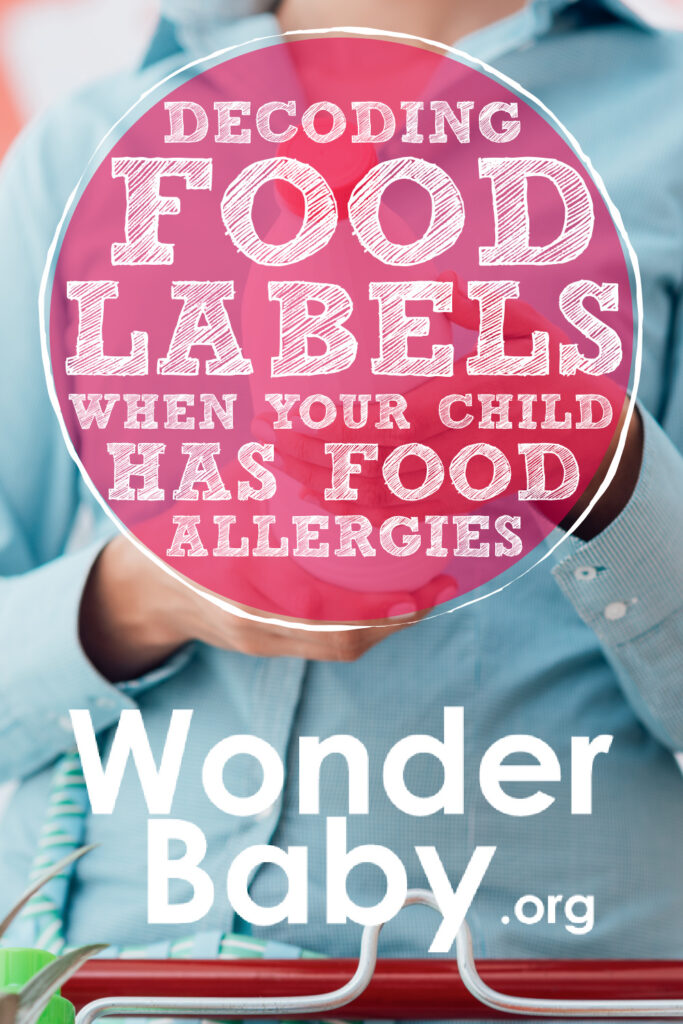Decoding Food Labels When Your Child Has Food Allergies

- Reading the labels on packaged food products is the single best way to find safe foods.
- Federal food laws require clear identification on packaged food labels if ingredients contain one of the top nine food allergens.
- Mandated food allergen labeling can reveal surprising sources of major food allergens.
- Non-food sources, such as dietary supplements and cosmetics, can also contain major food allergens.
Do you ever feel as though reading a food label is similar to learning a second language? Aside from the basic facts like calories, fats, sugars, and proteins, there’s the ingredient list, which can leave some consumers feeling like they’ve entered a chemistry lab. Soy lecithin, whey protein, natural and artificial flavors— what are they, and what are the implications for someone with severe food allergies?
Learning to decode food labels to ensure product safety for your child with food allergies is a skill that, like language acquisition, takes time and practice. Fortunately, as you learn the ins and outs of your child’s specific allergens and where they tend to appear in foods, accurately interpreting the information on a product label gets easier.
Not sure where to begin as you learn to deconstruct food labels? We can help you learn how to interpret some of the information behind the ingredients— without the science lecture.
The Importance of Reading Food Labels

Who has time to read a food label? You do! A 2022 study entitled The Risk of Undeclared Allergens on Food Labels for Pediatric Patients in the European Union11. Martínez-Pineda, M., & Yagüe-Ruiz, C.. The Risk of Undeclared Allergens on Food Labels for Pediatric Patients in the European Union. Nutrients. 2022;14(8), 1571. https://doi.org/10.3390/nu14081571 published in Nutrients by Martinez-Pineda et al reports that “milk (20.5%), gluten (14.8%), and nuts (10.9%) are the allergens with a higher presence that frequently affect the pediatric population and the implicated products. In 80% of the notifications concerning milk and milk derivatives, the specific compound present (lactose or lactoprotein) was not identified. The large quantity (7.6%) of undeclared allergens in ‘free-from-allergen’ products was also remarkable, especially in regard to the supposedly not-present allergens.”
Simply stated, there is no substitute for reading the food labels of packaged foods and food products that you intend to serve to your child with a food allergy. Though labeling and consumer protection laws are in place, food manufacturers may change their recipes at will; reading food labels—every time—is the primary way to avoid exposure to a major food allergen.
Food Labeling Laws
On January 1, 2006, the Food Allergen Labeling and Consumer Protection Act22. Center for Food Safety and Applied Nutrition. Food Allergen Labeling and Consumer Protection Act of 2004 (FALCPA). U.S. Food and Drug Administration. 2022. https://www.fda.gov/food/food-allergensgluten-free-guidance-documents-regulatory-information/food-allergen-labeling-and-consumer-protection-act-2004-falcpa (FALCPA) went into effect. This law was a breakthrough in food allergy safety for affected children and adults, as it mandated that the top eight major allergens be clearly identified for all food products regulated by the Food and Drug Administration (FDA).
With the introduction of sesame as the ninth major food allergen, the food allergy laws under FALPCA have now been updated to Food Allergy Safety, Treatment, Education, and Research (FASTER)33. Public Law 117 – 11 – Food Allergy Safety, Treatment, Education, and Research Act of 2021’’ or the “FASTER Act of 2021. GovInfo. 2022. https://www.govinfo.gov/app/details/PLAW-117publ11, which became effective on January 1, 2023.
FALCPA requires that any foods regulated under their guidance must publish the following on their food labels:
- There must be clear language if a food product contains one or more major food allergens.
- The specific type of nut (peanut or tree nuts like almond, cashew, pistachio, etc.) present in the food product.
- The specific type of fish (for example, bass or tuna) present in the food product.
- The specific type of crustacean shellfish (for example, shrimp or crab) present in the food product.
A consumer protection act standardizes food allergen labeling across all manufacturers, thereby helping consumers avoid foods that may be unsafe for them.
How to Read a Food Label for Allergens

You’ve picked up a product that looks promising in accommodating your child’s food allergy. Now that you’re face to face with the food label, how will you interpret the data that’s presented?
The Ingredients List
Allergen labeling and consumer laws require that an ingredient list be posted on the outer packaging (usually on the back or side) of each food item intended for human consumption.
This list will describe all substances in the food and are listed in order of quantity, from highest to lowest.
FDA guidance requires44. Food allergen labeling. Kids With Food Allergies. 2022. https://kidswithfoodallergies.org/living-with-food-allergies/choosing-safe-foods/label-law-food-allergen-labeling-consumer-protection-act/ that, for each food product regulated by their agency, either the common or usual name of a major food allergen must then be followed by the food source in parentheses in the list of ingredients (for example, “tree nuts (almond)”) or be included in a section after or near the ingredient list entitled “Contains,” which would then list the name of the food source from which the major food allergen is derived (for example, “Contains Egg and Soy”).
Note: FALCPA does not cover fresh fruits and vegetables in their natural state, as well as any highly refined oils made from a food specified in the top nine common food allergens.
Understanding “May Contain” Statements
Current good manufacturing practices include the use of a voluntary “may contain” statement. This phrase is used when a product doesn’t contain a major allergen in and of itself but is highly likely to be contaminated by cross-contact. For example, individuals with celiac disease may encounter cross-contact through oat products—while oats don’t contain the gluten protein, they may become contaminated because oats and wheat are often grown and harvested together. Oats may also be processed on product lines dusted with wheat-containing flour.
In our house, we treat a “may contain” statement on a case-by-case basis: A particular product may be consumed if it holds a “may contain” designation after consultation with healthcare professionals and discussions with the company to learn more about their manufacturing processes and the risk of incurring allergic reactions.
Identifying Hidden Allergens

When susceptible individuals have an allergic reaction55. FDA. Have Food Allergies? Read the Label. U.S. Food and Drug Administration. 2023. https://www.fda.gov/consumers/consumer-updates/have-food-allergies-read-label to a food allergen, they are reacting to the protein found in that food. For instance, the gluten protein is found in wheat, barley, and rye, which makes those grains off-limits to someone with celiac disease or a gluten-free individual. If you don’t know that gluten is found in other grains besides wheat, you risk an allergic reaction or food allergy emergency66. Food Allergy & Anaphylaxis Emergency Care Plan. FoodAllergy.org. https://www.foodallergy.org/living-food-allergies/food-allergy-essentials/food-allergy-anaphylaxis-emergency-care-plan when ingesting these products.
Check out the following list of terms the food industry utilizes that may signal the presence of common food allergens:
| Food Allergen | Among others, may be listed as: |
| Dairy (milk) | Butter flavoring, buttermilk, buttermilk solids, casein, caseinates, cheese powder, cheese seasoning, cream, dry milk, hydrolyzed caseinate, lactose, lactoprotein, milk powder, milk products, milk protein, sodium caseinate, whey, and whey powder. |
| Wheat (gluten) | Barley syrup, glucose syrup, hydrolyzed wheat protein, hydrolyzed wheat starch, malt, malt flavoring, modified starch, modified food starch, semolina, spelt, wheat bran, wheat germ, wheat grass, wheat protein, wheat starch, and whole wheat berries. |
| Soy | Soybean oil, soy protein, vegetable gum, and vegetable starch. |
| Eggs | Albumin (also spelled albumen), egg whites, egg yolks, lysozyme, meringue, meringue powder, ovalbumin, ovomucoid, ovomucin, and ovovitellin. |
| Peanuts | Artificial nuts, beer nuts, hydrogenated peanut oil, lupin (or lupine), mandelonas, nut meat, nut meal, peanut flour, peanut oil, and peanut protein hydrolysate. |
| Tree nuts | Artificial nuts, black walnut hull extract (flavoring), natural flavor, natural flavoring, nut meal, nut meat, nut milk, nut oil, nut paste, pure nut extracts, pine nut, shea nut, and walnut hull extract. |
| Fish | All varieties of fish, as well as anchovies, fish flavoring, fish gelatin (made from the skin and bones of fish), fish oil, imitation or artificial fish, or shellfish. |
| Crustacean shellfish | Barnacle, crab, crawfish, krill, lobster, prawns, shrimp, and others |
| Sesame | Benne/benne seed/benniseed, gomasio, sesame flour, sesame oil, sesame paste, sesame seed, sesamum indicum, tahini. |
Food manufacturers may change preparations or recipes at any point, which may make a previously safe product unsafe. Always check packaged food labels before consumption.
Tips for Avoiding Common Allergens

Under current allergen labeling requirements1313. Center for Food Safety and Applied Nutrition. Food Allergies. U.S. Food and Drug Administration. 2023. https://www.fda.gov/food/food-labeling-nutrition/food-allergies#:~:text=The%20law%20requires%20that%20food,(for%20example%2C%20buttermilk). from the FDA, food ingredient labels must include a “contains” statement if the product in question contains one of the nine foods federally recognized as a major food allergen.
While that information is helpful, it may not provide all the information you need to help decide on the safety of certain foods.
Consider the following tips as you learn about the packaged food industry and read food labels to prevent allergic reactions for your child:
- Learn how your favorite product is made. Manufacturing processes can differ from brand to brand, even with the same item. Does the company that makes your favorite product allow the top allergens into the same facility? How do they manage their presence if so?
- Shared equipment. Some gluten-free manufacturers I know of have dedicated facilities and product lines on which to make their specialty products, but not all companies choose such practices. For instance, do they use the same equipment to make peanut-containing and peanut-free products? If so, are the lines cleaned before making specialty items?
- Learn the lingo. Pure or natural flavorings are often derived from the substance that occurs in nature, which may be allergenic. For example, pure almond extract is derived from actual almonds and is not safe for someone with a tree nut allergy. Imitation almond extract (generally made from peach or plum pits) could likely be safely used by these individuals to flavor desired foods.
Speaking with customer service agents for major manufacturers about your child’s food allergies may feel awkward at first, but can be an invaluable way to get necessary information directly from the source.
Vitamins/Dietary Supplements, Cosmetics, and Common Allergens

The Food and Drug Administration is also responsible for overseeing the regulation of all vitamins or supplements1414. FDA. Facts about Dietary Supplements. U.S. Food and Drug Administration. 2023. https://www.fda.gov/news-events/rumor-control/facts-about-dietary-supplements, as well as cosmetics1515. FDA. FDA Authority Over Cosmetics: How Cosmetics Are Not FDA-Approved, but Are FDA-Regulated. U.S. Food and Drug Administration. 2022. https://www.fda.gov/cosmetics/cosmetics-laws-regulations/fda-authority-over-cosmetics-how-cosmetics-are-not-fda-approved-are-fda-regulated#:~:text=FDA%20regulates%20cosmetics%20under%20the,laws%20are%20enacted%20by%20Congress.. These substances follow the regulations of the Federal Food, Drug, and Cosmetic Act1616. Lam C, Patel P.. Food, Drug, and Cosmetic Act. In: StatPearls [Internet]. Treasure Island (FL): StatPearls Publishing. 2023. https://www.ncbi.nlm.nih.gov/books/NBK585046/ (FD&C), which has different requirements than that of FALCPA or FASTER.
Do your favorite products contain major allergens?
| Food Allergen | Can also be found in: |
| Dairy (milk) | Protein powders, protein beverages and bars, probiotics, whey powders, infant formula, pet foods, medications, shampoo, conditioner, and soap. |
| Wheat (gluten) | Medications (used as a binder for the active ingredient), play dough, modeling clay, lotions, skincare, and cosmetics. |
| Soy | Protein powders, protein beverages and bars, hair products, infant formula, pet food, medications, soy supplements, soaps, and moisturizers. |
| Eggs | Egg substitutes, lecithin, flu and other vaccines, protein powders, protein beverages and bars; many uses in the cosmetic industry. |
| Peanuts | Protein powders, protein beverages and bars, pet food, in compost as lawn fertilizers, massage oils, moisturizers, and skincare products. |
| Tree nuts | Protein powders, protein beverages and bars. Common in cosmetic oils, cream moisturizers, hair products, shaving cream, and lip balms; some are used in makeup. Crushed walnut shells can be used in facial/body scrubs as an exfoliator. |
| Fish | Prenatal vitamins, fish oil supplements, omega-3 supplements, docosahexaenoic acid (DHA) supplements, emollients, and guanine from fish scales in bath products, shampoo, conditioner, fragrances, lipstick, and nail products. |
| Crustacean shellfish | Glucosamine, seafood flavoring |
| Sesame | Body oils, creams, hair care products, lipsticks, medications, nutritional supplements, perfumes, and pet foods. |
This list is not exhaustive; reactions or cross-reactions to other unmentioned products are possible. Talk with your healthcare provider if you have questions or concerns about the safety of a particular product.
Other Names for Major Food Allergens
As you work to decode product labels to determine safety for your loved one with a food allergy, consider that allergens on non-food items, unlike their edible counterparts, aren’t usually clearly marked. To make matters even trickier, plant-based ingredients3131. Ferreira, M., Magalhães, M., Oliveira, R., Sousa-Lobo, J., & Almeida, I.. Trends in the Use of Botanicals in Anti-Aging Cosmetics. Molecules. 2021;26(12), 3584. https://doi.org/10.3390/molecules26123584 that may contain allergens are likely to use their Latin or International Nomenclature Cosmetic Ingredient3232. INCI. Personal Care Products Council. https://www.personalcarecouncil.org/resources/inci/#:~:text=What%20is%20INCI%3F,recognized%20to%20identify%20cosmetic%20ingredients. (INCI) names as opposed to “plain English”—leaving the average consumer baffled.
| Major Allergen | Latin or INCI name |
| Dairy (milk) | Lac, caprae lac (goat’s milk; tends to have cross-reactions with cow’s milk), lactoferrin, colostrum, and lactoperoxidase. |
| Wheat (gluten) | Triticum vulgare (wheat), hordeum vulgare (barley), secale cereale (rye), and avena sativa (oat). |
| Soy | Glycine max, soya |
| Eggs | Ovum |
| Peanuts | Arachis, arachis hypogea |
| Tree nuts | Prunus [amygdalus] dulcis/amara/sativa (almond), bertholletia excelsa (Brazil nut), anacardium occidentale (cashew), corylus rostrata/avellana (hazelnut), macadamia ternoifolia (macadamia), carya illinoinensis (pecan), pistacia vera (pistachio), juglans regia/nigra (walnut), and others. |
| Fish | Piscum lecur, gad lecur |
| Crustacean shellfish | Chitin, chitosan (cosmetic ingredient made from the shells of crustacenas and may be found in products as chitosan succinamide or trimethyl chitosan). |
| Sesame | Sesamum indicum |
By searching for the Latin name in the INCI database3333. Inci Database Directory. INCI Database: International Nomenclature of Cosmetic Ingredients. https://cosmetics.specialchem.com/inci-names, you can view manufacturing data and a listing of where the allergens are used in particular products.
While it may take some time to learn to interpret a “may contain” or ingredient statement, rest assured that learning the ins and outs of food labeling is one of the best ways you can protect your child with food allergies from significant allergic reactions.
References
- Martínez-Pineda, M., & Yagüe-Ruiz, C. (2022). The Risk of Undeclared Allergens on Food Labels for Pediatric Patients in the European Union. Nutrients, 14(8), 1571. https://doi.org/10.3390/nu14081571
- Center for Food Safety and Applied Nutrition. (2022, November 29). Food Allergen Labeling and Consumer Protection Act of 2004 (FALCPA). U.S. Food and Drug Administration. https://www.fda.gov/food/food-allergensgluten-free-guidance-documents-regulatory-information/food-allergen-labeling-and-consumer-protection-act-2004-falcpa
- Public Law 117 – 11 – Food Allergy Safety, Treatment, Education, and Research Act of 2021’’ or the “FASTER Act of 2021. GovInfo. (2021). https://www.govinfo.gov/app/details/PLAW-117publ11
- Food allergen labeling. Kids With Food Allergies. (2022, December 16). https://kidswithfoodallergies.org/living-with-food-allergies/choosing-safe-foods/label-law-food-allergen-labeling-consumer-protection-act/
- FDA. (2023, January 10). Have Food Allergies? Read the Label. U.S. Food and Drug Administration. https://www.fda.gov/consumers/consumer-updates/have-food-allergies-read-label
- Food Allergy & Anaphylaxis Emergency Care Plan. FoodAllergy.org. (n.d.). https://www.foodallergy.org/living-food-allergies/food-allergy-essentials/food-allergy-anaphylaxis-emergency-care-plan
- Egg Allergy. FoodAllergy.org. (n.d.). https://www.foodallergy.org/living-food-allergies/food-allergy-essentials/common-allergens/egg
- Peanut Allergy. FoodAllergy.org. (n.d.). https://www.foodallergy.org/living-food-allergies/food-allergy-essentials/common-allergens/peanut
- Tree Nut Allergy. FoodAllergy.org. (n.d.). https://www.foodallergy.org/living-food-allergies/food-allergy-essentials/common-allergens/tree-nut
- Fish Allergy. FoodAllergy.org. (n.d.). https://www.foodallergy.org/living-food-allergies/food-allergy-essentials/common-allergens/fish
- Shellfish Allergy. FoodAllergy.org. (n.d.). https://www.foodallergy.org/living-food-allergies/food-allergy-essentials/common-allergens/shellfish
- Sesame Allergy. FoodAllergy.org. (n.d.). https://www.foodallergy.org/living-food-allergies/food-allergy-essentials/common-allergens/sesame
- Center for Food Safety and Applied Nutrition. (2023, January 10). Food Allergies. U.S. Food and Drug Administration. https://www.fda.gov/food/food-labeling-nutrition/food-allergies#:~:text=The%20law%20requires%20that%20food,(for%20example%2C%20buttermilk).
- FDA. (2023, May 16). Facts about Dietary Supplements. U.S. Food and Drug Administration. https://www.fda.gov/news-events/rumor-control/facts-about-dietary-supplements
- FDA. (2022, March 2). FDA Authority Over Cosmetics: How Cosmetics Are Not FDA-Approved, but Are FDA-Regulated. U.S. Food and Drug Administration. https://www.fda.gov/cosmetics/cosmetics-laws-regulations/fda-authority-over-cosmetics-how-cosmetics-are-not-fda-approved-are-fda-regulated#:~:text=FDA%20regulates%20cosmetics%20under%20the,laws%20are%20enacted%20by%20Congress.
- Lam C, Patel P. Food, Drug, and Cosmetic Act. [Updated 2023 Jul 31]. In: StatPearls [Internet]. Treasure Island (FL): StatPearls Publishing; 2023 Jan-. Available from: https://www.ncbi.nlm.nih.gov/books/NBK585046/
- Caglayan-Sozmen, S., Santoro, A., Cipriani, F., Mastrorilli, C., Ricci, G., & Caffarelli, C. (2019). Hazardous Medications in Children with Egg, Red Meat, Gelatin, Fish, and Cow’s Milk Allergy. Medicina, 55(8), 501. https://doi.org/10.3390/medicina55080501
- Figueiredo, A., Couto, M., & Costa, I. M. (2021). Milk related excipients in medications: concerns with cow’s milk protein allergy. Annals of Medicine, 53(sup1). https://doi.org/10.1080/07853890.2021.1896091
- Gluten in medicine, vitamins & supplements. Celiac Disease Foundation. (n.d.). https://celiac.org/gluten-free-living/gluten-in-medicine-vitamins-and-supplements/
- Do I have to use gluten-free skincare and body products? National Celiac Association. (2022). https://nationalceliac.org/celiac-disease-questions/do-i-have-to-use-gluten-free-skincare-products/
- Soy Allergy. FoodAllergy.org. (n.d.). https://www.foodallergy.org/living-food-allergies/food-allergy-essentials/common-allergens/soy
- Centers for Disease Control and Prevention. (2023, August 25). Flu Vaccine and People with Egg Allergies. Centers for Disease Control and Prevention. https://www.cdc.gov/flu/prevent/egg-allergies.htm#:~:text=Most%20flu%20vaccines%20today%20are,of%20egg%20protein%20called%20ovalbumin.
- Zhang, X., Chelliappan, B., S, R., & Antonysamy, M. (2021). Recent Advances in Applications of Bioactive Egg Compounds in Nonfood Sectors. Frontiers in Bioengineering and Biotechnology, 9. https://doi.org/10.3389/fbioe.2021.738993
- Peanut Acid. Cosmetics Info. (n.d.). https://www.cosmeticsinfo.org/ingredients/peanut-acid/#:~:text=In%20cosmetics%20and%20personal%20care,care%20products%2C%20and%20skin%20cleansers.
- Docosahexaenoic acid (DHA). Mount Sinai Health System. (n.d.). https://www.mountsinai.org/health-library/supplement/docosahexaenoic-acid-dha
- Guanine. Cosmetics Info. (n.d.). https://www.cosmeticsinfo.org/ingredients/guanine/#:~:text=Guanine%20is%20a%20crystalline%20material,shampoos%20and%20skin%20care%20products.
- Mayo Foundation for Medical Education and Research. (2023, August 10). Glucosamine. Mayo Clinic. https://www.mayoclinic.org/drugs-supplements-glucosamine/art-20362874
- Sesame Allergy. FoodAllergy.org. (n.d.). https://www.foodallergy.org/living-food-allergies/food-allergy-essentials/common-allergens/sesame
- Bhat, K. V., Kumari, R., Pathak, N., & Rai, A. K. (2014). Value Addition in Sesame: A Perspective on Bioactive Components for Enhancing Utility and Profitability. Pharmacognosy Reviews, 8(16), 147. https://doi.org/10.4103/0973-7847.134249
- Chidambaram, S. B., Pandian, A., Sekar, S., Haridass, S., Vijayan, R., Thiyagarajan, L. K., Ravindran, J., Balaji Raghavendran, H. R., & Kamarul, T. (2015). Sesame indicum, a nutritional supplement, elicits antiamnesic effect via cholinergic pathway in scopolamine intoxicated mice. Environmental Toxicology, 31(12), 1955–1963. https://doi.org/10.1002/tox.22196
- Ferreira, M., Magalhães, M., Oliveira, R., Sousa-Lobo, J., & Almeida, I. (2021). Trends in the Use of Botanicals in Anti-Aging Cosmetics. Molecules, 26(12), 3584. https://doi.org/10.3390/molecules26123584
- INCI. Personal Care Products Council. (2023, August 16). https://www.personalcarecouncil.org/resources/inci/#:~:text=What%20is%20INCI%3F,recognized%20to%20identify%20cosmetic%20ingredients.
- Inci Database Directory. INCI Database: International Nomenclature of Cosmetic Ingredients. (n.d.). https://cosmetics.specialchem.com/inci-names

The information WonderBaby provides is not intended to be, and does not constitute, medical or other health advice or diagnosis and should not be used as such. Always consult with a qualified medical professional about your specific circumstances.
Related Posts

Feeding and Eating, Special Needs
Feeding Therapy Approaches for Infants with Special Needs
Many children with special needs have feeding difficulties. Working with a speech therapist, being patient, and experimenting with textures can help.

Feeding and Eating
Unexpected Foods That Cause Allergen Cross-Reactivity
A variety of unexpected foods and environmental substances can trigger an allergic reaction through cross-reactivity to food proteins.

Feeding and Eating
Easing Anxiety for Families Facing Food Allergies
Ongoing physical preparations and speaking openly about anxiety can ease the transition from diagnosis to living well with a food allergy.